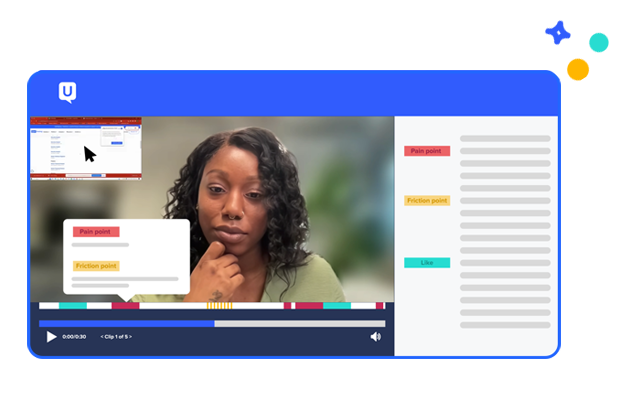
How to improve your user experience

A customer's interaction with your website, mobile app, or digital experience can be a powerful asset or a brow-furrowing puzzle. An excellent user experience (UX) encourages browsing, clicks, purchases, and repeat visits. A bad one will send your target audience looking to buy elsewhere. While improving your user experience is the plan, a total revamp of your website or mobile app is rarely necessary. UX designers can save time and resources with consistent, customer-centric efforts.
Follow our guide below to learn how to improve your user experience.
The fundamentals of a great user experience
User experience goes beyond surface-level design. It encompasses usability, accessibility, and emotional engagement for your website or mobile app users. The following core factors contribute to a delightful UX:
- Web design and visuals: The interplay between visual hierarchy, use of white space, visual elements, and overall aesthetics
- Functionality: How smoothly the platform works, including responsiveness, mobile-friendly features, and navigation
- Content: The relevance, clarity, quality, and readability of blog post content, calls to action, website pages, and other text
- Performance: The load times, reliability, and speed of your website and mobile app
- Accessibility: Ensuring that users with diverse abilities can access and use the platform effectively
To improve your website, focus on UX design that blends the elements above. In the next sections, we’ll explore these factors to help you conquer UX and deliver fast, engaging content and visuals that captivate your target customers.
Dos to improve your user experience
Designing with the user in mind requires systematic attention to key strategies and best practices. The following “dos” are critical for creating websites and mobile apps that surprise, delight, and engage your visitors.
Do conduct user research
Even if you believe you understand your target customers perfectly, things are always changing. Research will help you hone in on your audience and create a UX they’ll love. Ensure you offer the best user experience possible by conducting continuous discovery research into your processes.
To better understand your customers’ preferences, personas, and behaviors, you’ll need to know:
- The target demographic for your product or service. What age group are you targeting? Does your audience skew male or female? Are your customers students, parents, teachers, or working professionals? Be as detailed as possible.
- Your target customers’ interests. What do your customers do in their spare time? Do they travel, volunteer, attend concerts, paint, or play video games?
- Your audience’s preferred apps, products, and services. Check out reviews for similar apps on app stores, social media, and online review sites such as GetApp. What are users saying about these apps? What do they like and dislike? How do app creators respond to feedback? How can you do what they do, only better?
Based on your research, develop user personas that represent subgroups of your target audience. A typical user persona might include occupational information, demographics, pain points, and personal stories.
You should also conduct usability testing to collect direct feedback from users. Gather data on how they interact with your app or website to reveal areas for improvement.
One easy way to get user feedback is to add a survey on your website and after the checkout process. Ask users about their experience using your site: Did they find what they needed? What other features would be helpful to them? Look for patterns in user feedback. Are there any common threads you can use to improve the user experience?
Do incorporate responsive design and mobile optimization
More than 50% of U.S. online adults use smartphones to research and buy products and services, according to Forrester research. If users visit your site and have difficulty finding what they want, they’ll not likely stick around.
In the era of mobile devices, failing to implement a responsive design is a significant misstep. Non-responsive websites are challenging to navigate on smaller screens, leading to a poor user experience and more bounces. An unresponsive design can also harm your search engine rankings. Your website or app should adapt seamlessly to various screen sizes—mobile devices and desktops. Responsive design ensures your website’s features and content remain accessible and legible regardless of how users access them.
Even with a responsive design, your mobile platform can still suffer from poor performance. Slow-loading pages, unoptimized images, and unresponsive features can frustrate mobile users. Prioritize mobile performance to deliver a seamless experience across devices.
To optimize for mobile devices, prioritize a touch-friendly design that lets users navigate easily, tap on call-to-action buttons, complete web forms, and complete the checkout process. You should also reduce large media files to improve page-load speed.
Do focus on intuitive navigation
Overwhelming users with too much information, images, animations, or call-to-action buttons impedes navigation and detracts from the overall user experience. Instead, keep your design clean, organized, and focused on the content that matters most.
For a visually stunning user experience, follow a few basic design principles:
- Use up to two or three colors.
- Incorporate two fonts for the content and a third font for your logo.
- Include ample white space that makes it easy to read your content. Break up text with bullet points, images, and videos to improve readability.
- Have one goal for each page to keep users focused on the task. For example, your checkout page should only include the essentials for completing the process.
- Logically organize menus to make it easy for users to locate what they’re looking for without frustration.
- Implement a search feature with filters, auto-suggestion, and a search bar so users can locate content effortlessly.
Do create engaging content
According to Gartner research, nearly 48% of website visitors leave a primary landing page without engaging with marketing content. That’s quite a few lost opportunities—and a good reminder that your site needs relevant, helpful content to engage visitors.
Here are some tips to craft content that keeps users actively involved:
- Use storytelling. Share narratives, case studies, and customer testimonials that paint a picture of what it’s like to do business with your brand. Storytelling makes your content relatable and memorable, so customers think of your website the next time they need products or services like yours.
- Make it interactive. Use quizzes, calculators, and step-by-step forms to encourage user participation. You’ll also gain user research to inform your UX design process.
- Use personalization. Leverage the insights you’ve gained through user research and feedback to tailor content to user personas. Offer personalized recommendations for products and services based on user preferences.
- Add call-to-action buttons. Include clear, compelling calls to action that users will be excited to take after reading your content.
Do improve page-load speed
One reason users may bounce away from your website is slow loading times. Make your site stickier, boost conversions, increase search engine rankings, and reduce user frustration by optimizing your site for speed.
According to Deloitte research analyzing mobile site data of several brands across Europe and the United States, load time significantly impacts conversions. Just a 0.1-second change in load time boosted conversion rates by an average of 8% for retail sites and 10% for travel sites.
Moreover, that one-tenth of a second translated into retail consumers spending almost 10% more. Lead-generation and luxury users engaged more, increasing page views by 7% and 8%, respectively.
To improve page speed, follow these tips:
- Test your page speed across devices using Google’s PageSpeed Insights.
- Focus on simple navigation, accessibility on any device, and minimal clicks to find information—not only for a better user experience but also for faster loading.
- Optimize images for speed by using the smallest file size that maintains quality.
- Minify or optimize code by compressing it to the smallest size without impacting its operation.
- Clean up your content management system (CMS) by clearing the database of spam and unapproved comments, forgotten post drafts, and trashed posts and pages.
- Consider using a content delivery network (CDN), a server network that distributes bandwidth. Using a CDN eliminates the problem of using a single server to deliver content globally, thus distributing content faster.
Do make your site accessible
Make your site accessible to users with disabilities. Use alternative text for images, keyboard navigation, and text-to-speech compatibility. Familiarize yourself with the Web Content Accessibility Guidelines (WCAG) to verify your platform adheres to recognized accessibility standards—and creates a great user experience for all.
Don'ts for improving user experience
If you've been paying attention to the "dos" of improving user experience, you're well on your way to crafting an exceptional UX. However, understanding the “don’ts” to avoid is equally critical.
Don’t neglect user feedback
All your user research will be for naught if you don’t listen to your audience’s feedback. Don’t skip opportunities to enhance the UX; be open to reviews, comments, and suggestions. Be open to both qualitative and quantitative versions of feedback.
Acknowledge user input on reported bugs and usability issues, too. Act promptly to rectify issues and update users on completed fixes to build trust with your audience.
Don’t be inconsistent with branding
Avoid inconsistent design elements across your website or app. Deviating from your brand’s colors, fonts, and brand guidelines can create confusion and dissonance among users. Instead, maintain uniformity across fonts, color schemes, and style to create a cohesive and recognizable brand identity among your user base.
Don’t use overly intrusive pop-ups and ads
While monetizing your platform with ads is common, overloading it with advertisements can harm the user experience. Avoid intrusive ads that block content and disrupt navigation, including videos that autoplay with sound.
Likewise, popup forms serve an important role in capturing leads, but you should use them sparingly to avoid interrupting the user’s flow. An exit-intent popup can be a great way to collect leads without negatively impacting the user experience.
Best practices for a seamless user experience
The dos and don’ts above are an excellent starting point for creating a positive user experience. However, you can go beyond the basics with advanced best practices that will help you meet and exceed user expectations.
Take a mobile-first approach
Prioritize the mobile experience, whether you’re improving your existing UX design process or starting over. Mobile users are a significant chunk of your audience, no matter your industry, and focusing on mobile design forces you to prioritize essential features and content.
Taking a mobile-first approach doesn’t mean ignoring desktop users, however. As you scale design for larger screens, focus on enhancing the user experience rather than merely adapting the mobile design. The desktop version should be as responsive and user-friendly as its mobile counterpart.
Establish consistency across platforms
As you design for various devices, use the same features, design, and functionality. The layout may adapt to different screen sizes, but the core functions should remain consistent so users can access the same essential information and tools. This way, users will have the same experience on any device, building trust in your brand.
Incorporate user journey mapping
User journey maps help you visualize users' paths on your website or app. Understanding how they interact with your site from conversion entry may reveal potential obstacles in the user experience.
With visual maps, you can uncover deeper insights into users’ behaviors and preferences to improve the UX. Addressing bottlenecks and pain points will lead to a smoother user experience, greater satisfaction, and increased conversions.
Use A/B testing
Conduct controlled experiments to compare two or more versions of a design element, such as a landing page or call-to-action buttons—track which features perform best among groups and lead to the desired user actions.
With the data you gather from A/B testing, you’ll have empirical evidence of how your audience responds to design changes. Rather than assume what your users want, you can use these insights to make data-driven decisions and do further qualitative testing to get even more insights.
Keep improving
If you want to improve your user experience, remember the UX design process is not a one-time endeavor. Monitor user feedback and behavior to understand how your audience engages with your platform.
Doing so will allow you to continue improving on previous site versions while keeping users engaged with your content. As you gather user insights, implement regular optimizations, updates, and fixes.
Offering an exceptional user experience is within reach
Beyond technical and design considerations, developing empathy for users will go a long way toward engineering a memorable and delightful UX. Understanding your users' needs, preferences, and pain points will help to drive user-centric design, whether you’re iterating on an existing UX or creating something new.
In this age of evolving technological advancements and user behaviors, staying at the forefront of UX requires embracing emerging technologies, too. Artificial intelligence, voice interfaces, and immersive experiences reshape the digital world. Those who remain agile can gain a competitive edge.
Additionally, acknowledge the significance of inclusivity as you pursue better user experiences. Catering to a wide array of users, including those with disabilities, is a legal requirement in many jurisdictions and an ethical imperative. Designing with empathy for all can help to differentiate your organization in the digital landscape and encourage users to frequent your site.
Improving the user experience demands attention to detail, creativity, and awareness of emerging trends. It might sound like a tall order, but by focusing on continual improvements, you can make a lasting impact on your target audience

Get actionable insights today
Uncover human insights that make an impact. Book a meeting with our Sales team today to learn more.





